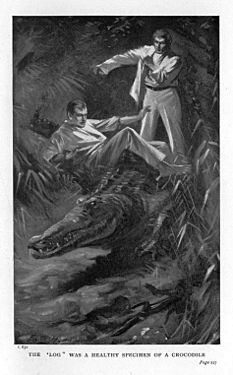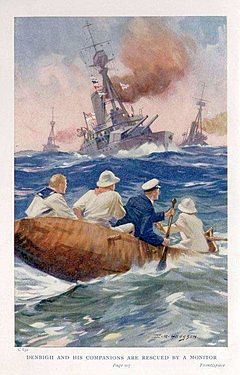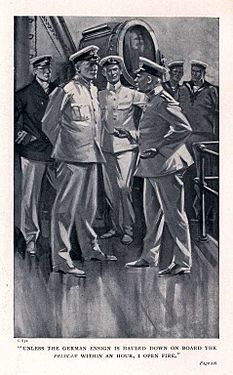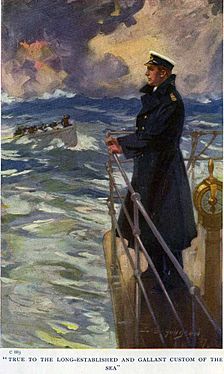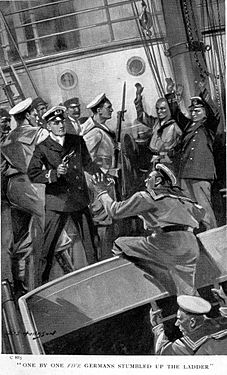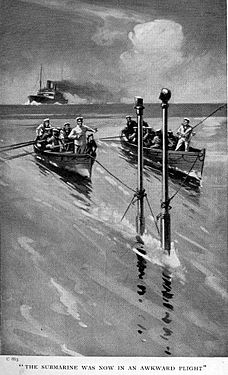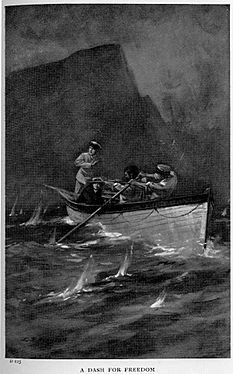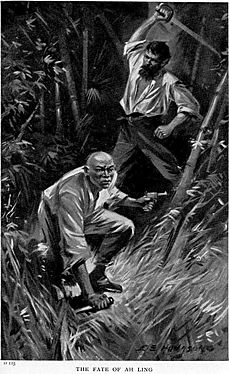Edward S. Hodgson facts for kids
Quick facts for kids
Edward S. Hodgson
|
|
|---|---|
| Born | 25 April 1866 |
| Died | 15 April 1937 (aged 70) |
| Nationality | Scottish |
| Occupation | Artist and Illustrator |
| Years active | 1886–1925 |
| Known for | Illustrating 17 books by Percy F. Westerman |
Edward S. Hodgson (born April 25, 1866 – died April 15, 1937) was a Scottish artist, etcher, and illustrator. He started his career at sea, but after an injury, he became an artist. He is most famous for illustrating 17 adventure books for boys by Percy F. Westerman.
Contents
Edward Hodgson's Life Story
Edward Hodgson was born in Arbroath, Angus, Scotland, on April 25, 1866. His father, Alfred, was a railway mechanic from France. His mother was Jessie Hanton Dryden.
Edward first worked as a sailor. But a leg injury forced him to leave the sea. Since he was good at painting, he decided to study art. He trained with W. M. Grubb at the High School of Dundee.
In 1894, Edward married Mary Wilson Crowe in Dundee. They had three children: David, Ronald, and George.
Later in 1894, Hodgson moved to Bushey, Hertfordshire, England. He lived there until he died in 1937. His wife Mary also lived there until her death in 1945.
Edward Hodgson worked as an artist almost until the end of his life. He passed away on April 15, 1937, and was cremated on April 24, 1937.
Edward Hodgson's Art Career
After leaving his life at sea, Edward studied art. Even though he changed careers, ships and the ocean often appeared in his artwork, especially in his illustrations. He did very well at the Dundee School of Art. He earned good grades in drawing and geometry in 1884 and 1885. After getting his teaching certificate, he taught art at several private schools.
He opened his own art studio in Dundee. He often showed his paintings in Dundee, especially landscapes and seascapes. In 1886, he exhibited a painting called The Lass that Baits the Line. People said it was a "promising work." He also showed beautiful watercolors and oil paintings in 1888.
Hodgson was also skilled at etching. Etching is a way of making prints by drawing on a metal plate with acid. In 1891, he created some "extremely pleasing" etchings. He even made a collection of six etchings showing scenes in Dundee. One of his etchings, Dundee from the River, was even accepted by Queen Victoria in 1892. In 1894, he had a "beautiful etching" of Fettes College in Edinburgh published in London.
In 1894, Hodgson moved to Bushey, Hertfordshire, to study at the art school run by Hubert von Herkomer. His later work showed how much he learned from Herkomer.
Magazine Illustrations
By 1900, Edward Hodgson started illustrating for magazines. His artwork appeared in many popular magazines, including:
- The Captain
- Cassell's Family Magazine
- Chums
- The Girl's Realm
- The Graphic
- The Illustrated London News
- Little Folks
- The Pall Mall Magazine
- Pearson's Magazine
- The Quiver
- The Royal Magazine
- The Sphere
- The Strand Magazine
- The Wide World Magazine
- The Windsor Magazine
- The Sketch
During the First World War, Hodgson mainly drew pictures of naval battles and ships for The Graphic magazine.
Book Illustrations
Edward Hodgson also illustrated many books. In 1896, he illustrated a new edition of Victor Hugo's The Toilers of the Sea. He also illustrated The Pearl Seekers by Alexander Macdonald in 1907.
He illustrated books for many authors, especially those who wrote adventure stories for young people. One of the most important authors he worked with was Percy F. Westerman. Hodgson illustrated seventeen books by Westerman.
Illustrations for books by Percy F. Westerman
Here are some examples of Hodgson's illustrations for books by Percy F. Westerman.
In 1916, Hodgson illustrated Rounding up the Raider by Westerman. This story is about three young Royal Navy officers who are captured by a German ship during their journey home. They escape and have more adventures in German East Africa. Illustrations are from Project Gutenberg.
Hodgson also drew pictures for Under the White Ensign by Westerman (1917). This book tells the story of two young Royal Naval Reserve officers and their adventures on an armed merchant cruiser in the Mediterranean Sea. Illustrations are from Project Gutenberg.
Another book Hodgson illustrated for Westerman was The Third Officer (1921). This story is about piracy after a war. The crew of a ship gets trapped on a small island and tries to escape in a small boat, facing more dangers. Illustrations are from Project Gutenberg.



